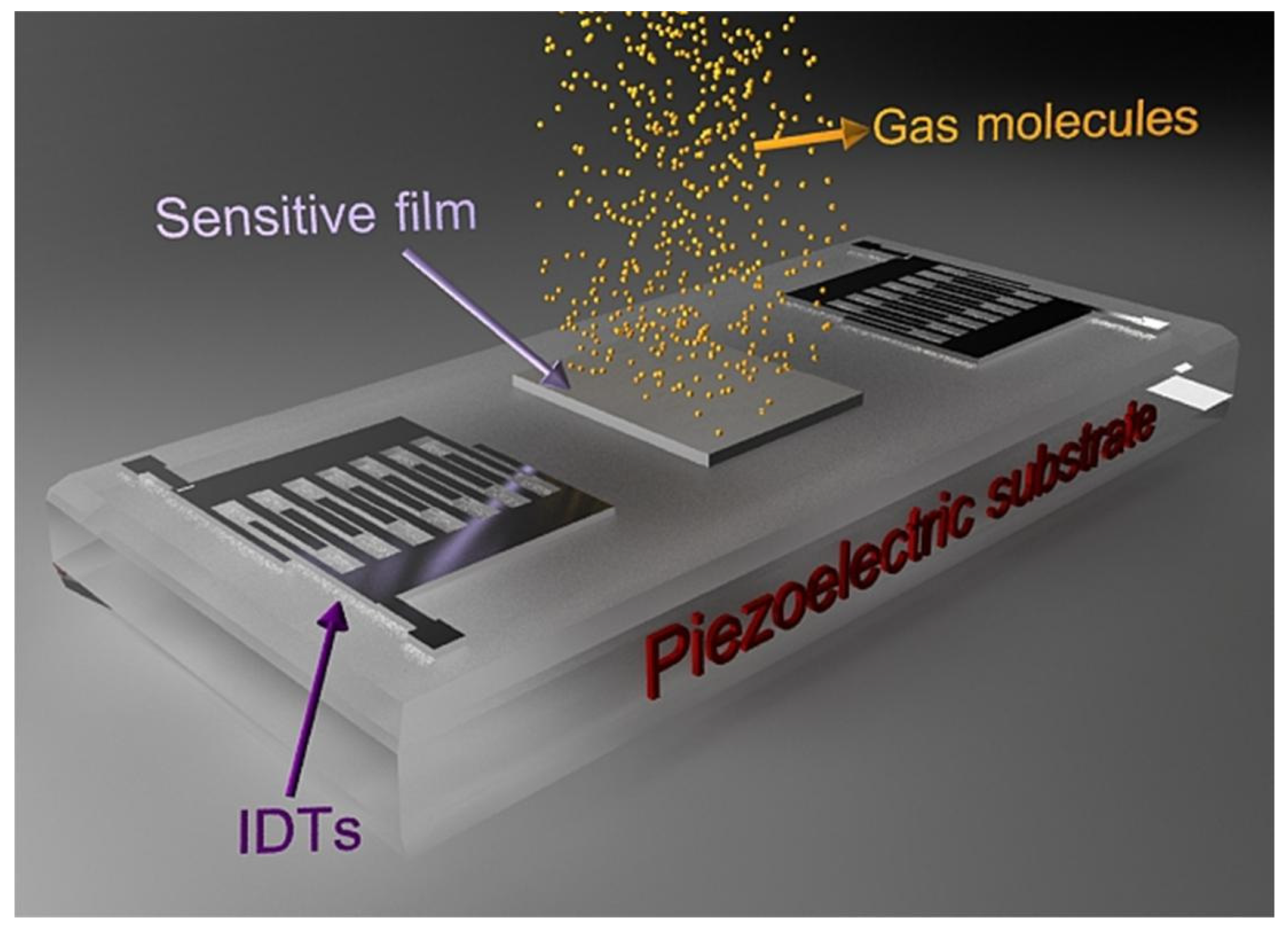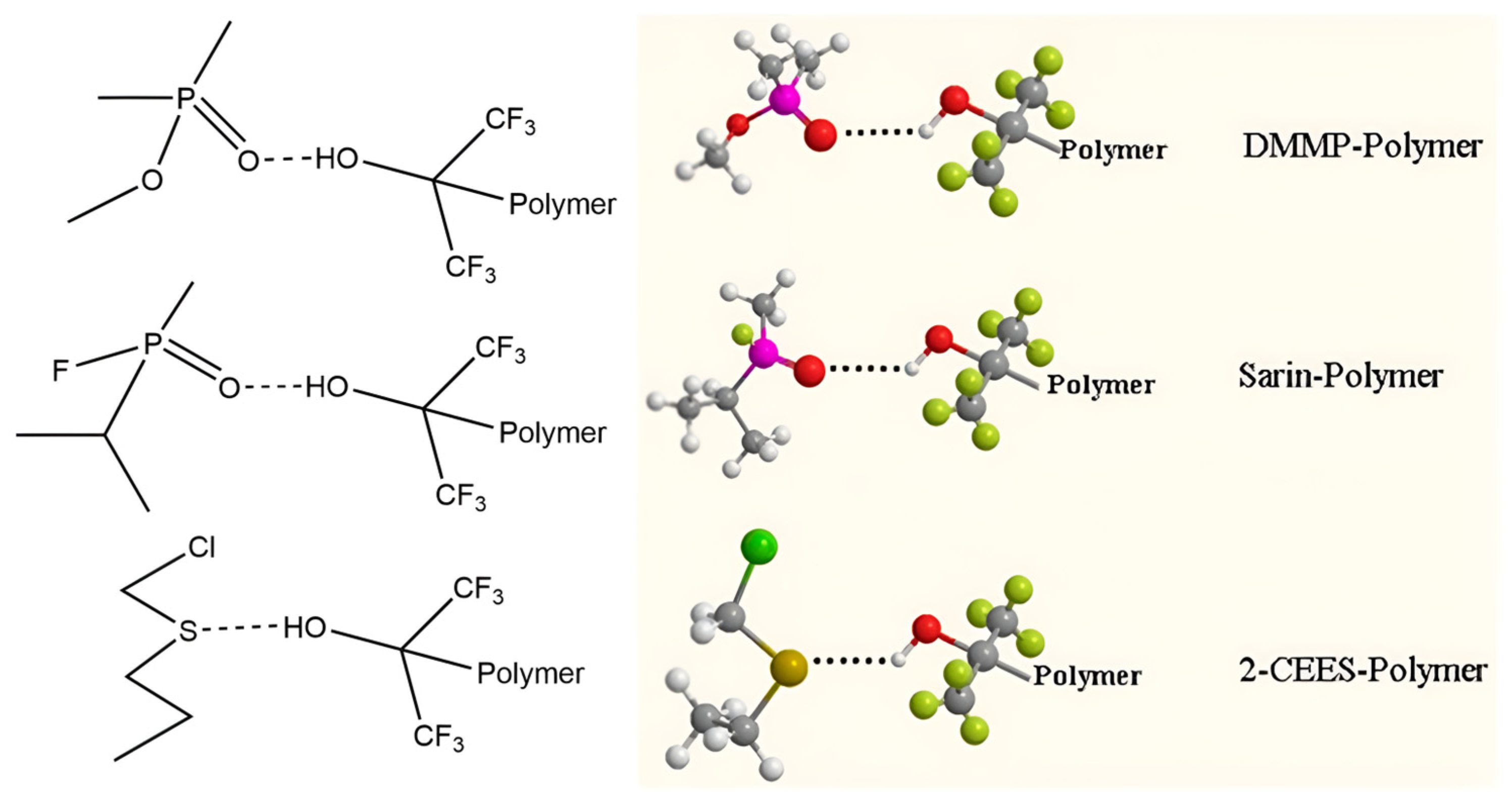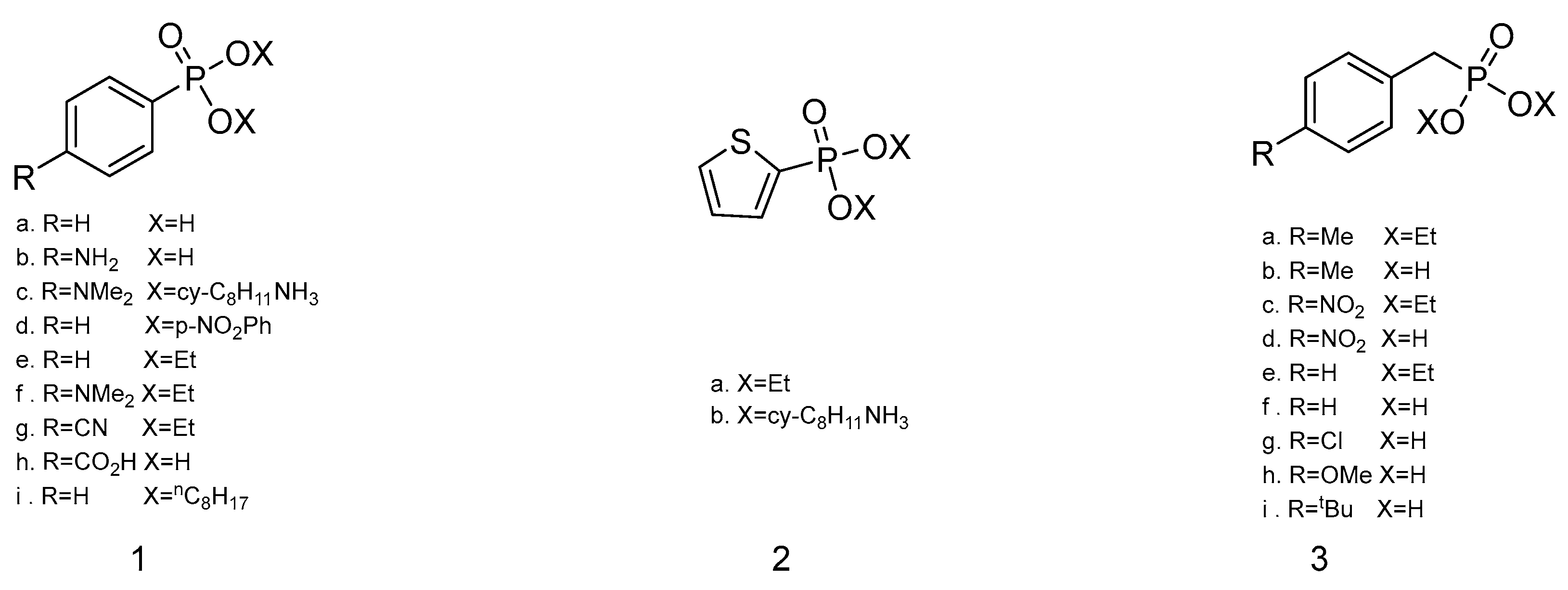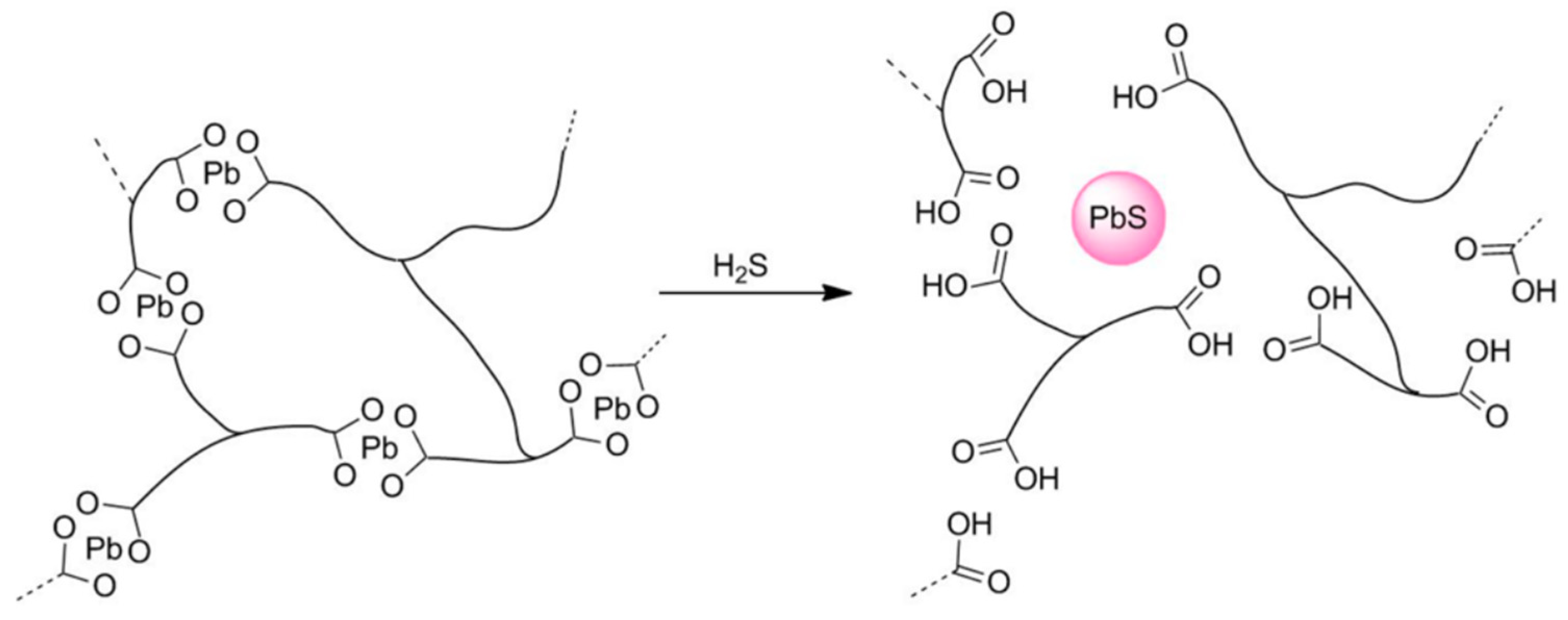Sensitive Materials Used in Surface Acoustic Wave Gas Sensors for Detecting Sulfur-Containing Compounds
Abstract
:1. Introduction
1.1. The Fundamental Concepts of SAW Sensors
1.2. Sulfur-Containing Hazardous Gas Species
1.2.1. Sulfur-Containing Chemical Agents
1.2.2. Sulfur-Containing Harmful Gas
2. Sensitive Functional Materials of Sulfur-Containing Agents and Their Simulants
2.1. Polymer
2.2. Organic Small Molecule
2.3. Other Kinds of Sensitive Materials
3. Sensitive Functional Materials of Sulfur-Containing Harmful Gases
3.1. Sensitive Functional Materials for SO2 Detection
3.2. Sensitive Functional Materials for H2S Detection
4. Conclusions
Author Contributions
Funding
Institutional Review Board Statement
Data Availability Statement
Conflicts of Interest
References
- Rayleigh, L. On waves propagated along the plane surface of an elastic solid. Proc. Lond. Math. Soc. 1885, s1-17, 4–11. [Google Scholar] [CrossRef]
- White, R.M.; Voltmer, F.W. Direct piezoelectric coupling to surface elastic waves. Appl. Phys. Lett. 1965, 7, 314–316. [Google Scholar] [CrossRef]
- Wohltjen, H.; Dessy, R. Surface acoustic wave probe for chemical analysis. I. Introduction and instrument description. Anal. Chem. 1979, 51, 1458–1464. [Google Scholar] [CrossRef]
- Wohltjen, H.; Dessy, R. Surface acoustic wave probes for chemical analysis. II. Gas chromatography detector. Anal. Chem. 1979, 51, 1465–1470. [Google Scholar] [CrossRef]
- Wohltjen, H.; Dessy, R. Surface acoustic wave probes for chemical analysis. III. Thermomechanical polymer analyzer. Anal. Chem. 1979, 51, 1470–1475. [Google Scholar] [CrossRef]
- Pan, Y.; Zhang, L.; Cao, B.; Xue, X.; Liu, W.; Zhang, C.; Wang, W. Effects of temperature and humidity on the performance of a PECH polymer coated SAW sensor. RSC Adv. 2020, 10, 18099–18106. [Google Scholar] [CrossRef] [PubMed]
- Fox, C.G.; Alder, J.F. Surface acoustic wave sensors for atmospheric gas monitoring. A review. Analyst 1989, 114, 997–1004. [Google Scholar] [CrossRef]
- Xu, G.Q.; Zhu, W.Z. Surface acoustic wave sensor and its application. Sens. World 1996, 2, 31–35. [Google Scholar]
- Li, H.Q.; Xia, G.Q. 158MHz surface acoustic wave fixed-delay line on GaAs. Chin. J. Semicond. 2000, 021, 93–96. [Google Scholar]
- Mandal, D.; Banerjee, S. Surface acoustic wave (SAW) sensors: Physics, materials, and applications. Sensors 2022, 22, 820. [Google Scholar] [CrossRef]
- Shi, Y.B.; Xiang, J.J.; Feng, Q.H.; Hu, Z.P.; Zhang, H.Q.; Guo, J.Y. Binary Channel SAW Mustard Gas Sensor Based on PdPc0.3PANI0.7 Hybrid Sensitive Film. J. Phys. Conf. Ser. 2006, 48, 292. [Google Scholar] [CrossRef]
- Liu, B.; Chen, X.; Cai, H.; Ali, M.M.; Tian, X.; Tao, L.; Yang, Y.; Ren, T. Surface acoustic wave devices for sensor applications. J. Semicond. 2016, 37, 021001. [Google Scholar] [CrossRef]
- Wen, C.; Zhu, C.; Ju, Y.; Xu, H.; Qiu, Y. A novel dual track SAW gas sensor using three-IDT and two-MSC. IEEE Sens. J. 2009, 9, 2010–2015. [Google Scholar] [CrossRef]
- Chen, C.Z.; Zuo, B.L.; Ma, J.Y.; Jiang, H.M. Detecting Mustard Gas Using High Q-value SAW Resonator Gas Sensors. In Proceedings of the 3rd Symposium on Piezoelectricity, Acoustic Waves and Device Applications, Nanjing, China, 5–8 December 2008. [Google Scholar]
- Chen, Z.; Zhou, J.; Tang, H.; Liu, Y.; Shen, Y.; Yin, X.; Zheng, J.; Zhang, H.; Wu, J.; Shi, X.; et al. Ultrahigh-frequency surface acoustic wave sensors with giant mass-loading effects on electrodes. ACS Sens. 2020, 5, 1657–1664. [Google Scholar] [CrossRef]
- Asad, M.; Sheikhi, M.H. Surface acoustic wave based H2S gas sensors incorporating sensitive layers of single wall carbon nanotubes decorated with Cu nanoparticles. Sens. Actuators B Chem. 2014, 198, 134–141. [Google Scholar] [CrossRef]
- Falconer, R.S. A versatile SAW-based sensor system for investigating gas-sensitive coatings. Sens. Actuators B Chem. 1995, 24, 54–57. [Google Scholar] [CrossRef]
- Li, D.; Zu, X.; Ao, D.; Tang, Q.; Fu, Y.; Guo, Y.; Bilawal, K.; Faheem, M.B.; Li, L.; Li, S.; et al. High humidity enhanced surface acoustic wave (SAW) H2S sensors based on sol–gel CuO films. Sens. Actuators B Chem. 2019, 294, 55–61. [Google Scholar] [CrossRef]
- Feng, W.; Xue, M.J.; Zhang, Q.L.; Liu, S.L.; Song, Q.H. Prefluorescent probe capable of generating active sensing species in situ for detections of sulfur mustard and its simulant. Sens. Actuators B Chem. 2022, 371, 132555. [Google Scholar] [CrossRef]
- Raber, E.; Jin, A.; Noonan, K.; McGuire, R.; Kirvel, R.D. Decontamination issues for chemical and biological warfare agents: How clean is clean enough? Int. J. Environ. Health Res. 2010, 11, 128–148. [Google Scholar] [CrossRef] [PubMed]
- Kumar, V.; Rana, H. Selective and sensitive chromogenic and fluorogenic detection of sulfur mustard in organic, aqueous and gaseous medium. RSC Adv. 2015, 5, 91946–91950. [Google Scholar] [CrossRef]
- Balali-Mood, M.; Hefazi, M. The pharmacology, toxicology, and medical treatment of sulphur mustard poisoning. Fundam. Clin. Pharmacol. 2005, 19, 297–315. [Google Scholar] [CrossRef]
- Wattana, M.; Bey, T. Mustard gas or sulfur mustard: An old chemical agent as a new terrorist threat. Prehosp. Disaster Med. 2009, 24, 19–29; discussion 30–31. [Google Scholar] [CrossRef] [PubMed]
- Chauhan, S.; D’cruz, R.; Faruqi, S.; Singh, K.K.; Varma, S.; Singh, M.; Karthik, V. Chemical warfare agents. Environ. Toxicol. Pharmacol. 2008, 26, 113–122. [Google Scholar] [CrossRef] [PubMed]
- Matatagui, D.; Martí, J.; Fernández, M.J.; Fontecha, J.L.; Gutiérrez, J.; Gràcia, I.; Cané, C.; Horrillo, M.C. Chemical warfare agents simulants detection with an optimized SAW sensor array. Sens. Actuators B Chem. 2011, 154, 199–205. [Google Scholar] [CrossRef]
- Katritzky, A.R.; Savage, G.P.; Offerman, R.J.; Pilarski, B. Synthesis of new microsensor coatings and their response to vapors-III arylphosphonic acids, salts and esters. Talanta 1990, 37, 921–924. [Google Scholar] [CrossRef]
- Raj, V.B.; Singh, H.; Nimal, A.T.; Sharma, M.U.; Gupta, V. Oxide thin films (ZnO, TeO2, SnO2, and TiO2) based surface acoustic wave (SAW) E-nose for the detection of chemical warfare agents. Sens. Actuators B Chem. 2013, 178, 636–647. [Google Scholar] [CrossRef]
- Bhomick, P.C.; Rao, K.S. Sources and Effects of Hydrogen Sulfide. J. Appl. Chem. 2014, 3, 914–918. [Google Scholar]
- Maldonado, C.S.; Weir, A.; Rumbeiha, W.K. A comprehensive review of treatments for hydrogen sulfide poisoning: Past, present, and future. Toxicol. Mech. Methods 2022, 33, 183–196. [Google Scholar] [CrossRef] [PubMed]
- Zou, Y.M.; Yang, Y.W. Research progress on fluorescence detection technology of atmospheric pollutant sulfur dioxide. Shanghai Chem. Ind. 2019, 44, 39–43. [Google Scholar]
- Khan, M.; Rao, M.; Li, Q. Recent advances in electrochemical sensors for detecting toxic gases: NO2, SO2 and H2S. Sensors 2019, 19, 905. [Google Scholar] [CrossRef] [PubMed]
- Grate, J.W.; Rose-Pehrsson, S.L.; Venezky, D.L.; Klusty, M.; Wohltjen, H. Smart sensor system for trace organophosphorus and organosulfur vapor detection employing a temperature-controlled array of surface acoustic wave sensors, automated sample preconcentration, and pattern recognition. Anal. Chem. 1993, 65, 1868–1881. [Google Scholar] [CrossRef]
- Liu, W.; Yu, J.; Pan, Y.; Zhao, J.; Huang, Q. Surface acoustic wave sensor detection of mustard gas with poly(epichlorohydrin) coatings. Chem. Sens. 2005, 25, 57–60. [Google Scholar]
- Liu, W.; Yu, J.; Pan, Y.; Zhao, J.; Huang, Q. The study of response character in the detection of HD by SAW-PECH sensor. Chem. Sens. 2005, 25, 52–54. [Google Scholar]
- Liu, W.; Pan, Y.; Zhao, J.; Zhao, J.; Yu, J.; Wang, Y.; Wu, Z. The adsorption study of SAW-PECH sensor to organosulfur agents. Chem. Sens. 2006, 26, 64–67. [Google Scholar]
- Liu, W.; Yu, J.; Pan, Y.; Huang, Q. Studying on the and application of SAW technology in detection of organosulfur chemical warfare agents. Piezoelectrics Acoustooptics 2006, 28, 14–16, +20. [Google Scholar]
- Chuanzhi, C.; Jinyi, M.; Boli, Z.; Hongmin, J. A Novel Toxic Gases Detection System Based on SAW Resonator Array and Probabilistic Neural Network. In Proceedings of the 8th International Conference on Electronic Measurement and Instruments, Xi’an, China, 16–18 August 2007. [Google Scholar]
- Matatagui, D.; Marti, J.; Fernandez, M.J.; Fontecha, J.L.; Gutierrez, J.; Gracia, I.; Cane, C.; Horrillo, M.C. Optimized design of a SAW sensor array for chemical warfare agents simulants detection. Procedia Chem. 2009, 1, 232–235. [Google Scholar] [CrossRef]
- Matatagui, D.; Fontecha, J.; Fernández, M.J.; Aleixandre, M.; Gràcia, I.; Cané, C.; Horrillo, M.C. Array of Love-wave sensors based on quartz/novolac to detect CWA simulants. Talanta 2011, 85, 1442–1447. [Google Scholar] [CrossRef]
- Matatagui, D.; Fernandez, M.J.; Fontecha, J.; Santos, J.P.; Gràcia, I.; Cané, C.; Horrillo, M.C. Love-wave sensor array to detect, discriminate and classify chemical warfare agent simulants. Sens. Actuators B Chem. 2012, 175, 173–178. [Google Scholar] [CrossRef]
- He, S.; Wang, W.; Li, S.; Liu, M. Advances in Polymer-Coated Surface Acoustic Wave Gas Sensor. In Proceedings of the 2011 16th International Solid-State Sensors, Actuators and Microsystems Conference, Beijing, China, 5–9 June 2011. [Google Scholar]
- Qi, J.; Wen, Y.M.; Li, P. Study on the detection of blister agent mustard by surface acoustic wave technology. J. Chongqing Univ. Posts Telecommun. (Nat. Sci. Ed.) 2017, 29, 494–499. [Google Scholar]
- Pan, Y.; Mu, N.; Liu, B.; Cao, B.; Wang, W.; Yang, L. A novel surface acoustic wave sensor array based on wireless communication network. Sensors 2018, 18, 2977. [Google Scholar] [CrossRef]
- Pan, Y.; Wang, P.; Zhang, G.; Yan, C.; Zhang, L.; Guo, T.; Wang, W.; Zhai, S. Development of a SAW poly (epichlorohydrin) gas sensor for detection of harmful chemicals. Anal. Methods 2022, 14, 1611–1622. [Google Scholar] [CrossRef] [PubMed]
- McGill, R.A.; Nguyen, V.K.; Chung, R.; Shaffer, R.E.; DiLella, D.; Stepnowski, J.L.; Mlsna, T.E.; Venezky, D.L.; Dominguez, D. The “NRL-SAWRHINO”: A nose for toxic gases. Sens. Actuator B Chem. 2000, 65, 10–13. [Google Scholar] [CrossRef]
- Matatagui, D.; Fernández, M.J.; Fontecha, J.; Sayago, I.; Gràcia, I.; Cané, C.; Horrillo, M.C.; Santos, J.P. Characterization of an array of Love-wave gas sensors developed using electrospinning technique to deposit nanofibers as sensitive layers. Talanta 2014, 120, 408–412. [Google Scholar] [CrossRef] [PubMed]
- Long, Y.; Wang, Y.; Du, X.; Cheng, L.; Wu, P.; Jiang, Y. The different sensitive behaviors of a hydrogen-bond acidic polymer-coated SAW sensor for chemical warfare agents and their simulants. Sensors 2015, 15, 18302–18314. [Google Scholar] [CrossRef] [PubMed]
- Katritzky, A.R.; Offerman, R.J.; Wang, Z. Utilization of pyridinium salts as microsensor coatings. Langmuir 1989, 5, 1087–1092. [Google Scholar] [CrossRef]
- Katritzky, A.R.; Offerman, R.J.; Aurrecoechea, J.M.; Savage, G.P. Synthesis and response of new microsensor coatings-II Acridinium betaines and anionic surfactants. Talanta 1990, 37, 911–919. [Google Scholar] [CrossRef]
- Katritzky, A.R.; Lam, J.N.; Faid-Allah, H.M. Synthesis of new microsensor coatings and their response to test vapors 2,4,6-trisubstituted-1,3,5-triazine derivatives. Talanta 1991, 38, 535–540. [Google Scholar] [CrossRef]
- Sayago, I.; Matatagui, D.; Fernández, M.J.; Fontecha, J.L.; Jurewicz, I.; Garriga, R.; Muñoz, E. Graphene oxide as sensitive layer in Love-wave surface acoustic wave sensors for the detection of chemical warfare agent simulants. Talanta 2016, 148, 393–400. [Google Scholar] [CrossRef]
- Fahim, F.; Mainuddin, M.; Mittal, U.; Kumar, J.; Nimal, A.T. Novel SAW CWA detector using temperature programmed desorption. IEEE Sens. J. 2021, 21, 5914–5922. [Google Scholar] [CrossRef]
- Kumar, J.; Nimal, A.T.; Mittal, U.; Kumar, V.; Singh, V.K. Effect of carrier gas on sensitivity of surface acoustic wave detector. IEEE Sens. J. 2022, 22, 8394–8401. [Google Scholar] [CrossRef]
- Leidl, A.; Hartinger, R.; Roth, M.; Endres, H.E. A new SO2 sensor system with SAW and IDC elements. Sens. Actuators B Chem. 1996, 34, 339–342. [Google Scholar] [CrossRef]
- Penza, M.; Cassano, G.; Sergi, A.; Sterzo, C.L.; Russo, M.V. SAW chemical sensing using poly-ynes and organometallic polymer films. Sens. Actuators B Chem. 2001, 81, 88–98. [Google Scholar] [CrossRef]
- Jakubik, W.P.; Urbanczyk, M.; Maciak, E.; Pustelny, T.; Stolarczyk, A. Polyaniline thin films as a toxic gas sensors in SAW system*. J. De Phys. IV (Proc.) 2005, 129, 121–124. [Google Scholar] [CrossRef]
- Wen, C.B.; Zhu, C.C.; Ju, Y.F.; Qiu, Y.Z. Experimental study on SAW SO2 Sensor Based on Carbon Nanotube-polyanilin Films. Piezoelectrics Acoustooptics 2009, 31, 157–160. [Google Scholar]
- Youssef, I.B.; Alem, H.; Sarry, F.; Elmazria, O.; Rioboo, R.J.; Arnal-Hérault, C.; Jonquières, A. Functional poly(urethane-imide) s containing Lewis bases for SO2 detection by Love surface acoustic wave gas micro-sensors. Sens. Actuators B Chem. 2013, 185, 309–320. [Google Scholar] [CrossRef]
- Yang, J.; Wang, T.; Zhu, C.; Yin, X.; Dong, P.; Wu, X. AgNWs@SnO2/CuO nanocomposites for ultra-sensitive SO2 sensing based on surface acoustic wave with frequency-resistance dual-signal display. Sens. Actuators B Chem. 2023, 375, 132966. [Google Scholar] [CrossRef]
- Lee, Y.J.; Kim, H.B.; Roh, Y.R.; Cho, H.M.; Baik, S. Development of a saw gas sensor for monitoring SO2 gas. Sens. Actuators A Phys. 1998, 64, 173–178. [Google Scholar] [CrossRef]
- Bryant, A.; Poirier, M.; Riley, G.; Lee, D.L.; Vetelino, J.F. Gas detection using surface acoustic wave delay lines. Sens. Actuators 1983, 4, 105–111. [Google Scholar] [CrossRef]
- Liu, X.; Wang, W.; Pan, Y.; Shao, S.; Mu, N. Research on detection system of surface acoustic wave sensor array based on Internet of Things. J. Zhengzhou Univ. (Eng. Sci.) 2016, 37, 58–61. [Google Scholar]
- Rabus, D.; Friedt, J.M.; Arapan, L.; Lamare, S.; Baqué, M.; Audouin, G.; Chérioux, F. Subsurface H2S detection by a surface acoustic wave passive wireless sensor interrogated with a ground penetrating radar. ACS Sens. 2020, 5, 1075–1081. [Google Scholar] [CrossRef]
- Zhao, L.; Che, J.; Cao, Q.; Shen, S.; Tang, Y. Highly sensitive surface acoustic wave H2S gas sensor using electron-beam-evaporated CuO as sensitive layer. Sens. Mater. 2023, 35, 2293–2304. [Google Scholar] [CrossRef]
- Wang, J.; Che, J.; Qiao, C.; Niu, B.; Zhang, W.; Han, Y.; Fu, Y.; Tang, Y. Highly porous Fe2O3-SiO2 layer for acoustic wave based H2S sensing: Mass loading or elastic loading effects? Sens. Actuators B Chem. 2022, 367, 132160. [Google Scholar] [CrossRef]
- Liu, X.; Wang, W.; Zhang, Y.; Pan, Y.; Liang, Y.; Li, J. Enhanced sensitivity of a hydrogen sulfide sensor based on surface acoustic waves at room temperature. Sensors 2018, 18, 3796. [Google Scholar] [CrossRef] [PubMed]
- Liu, X.; Zhang, Y.; Liang, Y.; Li, J.; Wang, W. Design of surface acoustic wave sensor for rapid detection of hydrogen sulfide. J. Zhengzhou Univ. (Eng. Sci.) 2019, 40, 43–46. [Google Scholar]
- Murakawa, Y.; Hara, M.; Oguchi, H.; Hamate, Y.; Kuwano, H. A Hydrogen Sulfide Sensor Based on a Surface Acoustic Wave Resonator Combined with Ionic Liquid. In Proceedings of the 14th International Meeting on Chemical Sensors, Nuremberg, Germany, 20–23 May 2012. [Google Scholar]
- Murakawa, Y.; Hara, M.; Oguchi, H.; Hamate, Y.; Kuwano, H. Surface acoustic wave based sensors employing ionic liquid for hydrogen sulfide gas detection. Microsyst. Technol. 2013, 19, 1255–1259. [Google Scholar] [CrossRef]










| Simulant | Simulated Chemical Warfare Agent (CWA) | Median Lethal Dose (LD50) Inhaled (ppm) | Ref. |
|---|---|---|---|
| Dimethyl methylphosphonate (DMMP) | Sarin (GB) | 18 | [25] |
| Dipropylene glycol monomethyl ether (DPGME) | Nitrogen mustard (HN) | 180 | [25] |
| Chloroethyl ethyl sulfide (CEES) | Distilled mustard (HD) | 140 | [26] |
| Dibutyl sulfide (DBS) | Distilled mustard (HD) | 140 | [27] |
| Chloroethyl phenyl sulfide (CEPS) | Distilled mustard (HD) | 140 | [27] |
| 1,5-Dichloropentane (DCP) | Distilled mustard (HD) | 140 | [25] |
| Dimethylacetamide (DMA) | Distilled mustard (HD) | 140 | [25] |
| 1,2-Dichloroethane (DCE) | Distilled mustard (HD) | 140 | [25] |
| Soman (GD) | 6 | [25] | |
| Dichloromethane (DCM) | Phosgene (CG) | 800 | [25] |
| Polymer | Abbr. | Method | c | r | s | a | b | l | R | Std Error |
|---|---|---|---|---|---|---|---|---|---|---|
| Poly(epichlorohydrin) | PECH | SAW | −0.75 | 0.44 | 1.44 | 1.49 | 1.3 | 0.55 | 0.993 | 0.11 |
| Device | Polymer Types | Coating Method | Analytes | Sensitivity or Limitation of Detection | Range of Detection | Advantages | Disadvantages | Ref. |
|---|---|---|---|---|---|---|---|---|
| 158 MHz four-channel SAW delay line sensor array | 1. PECH; 2. PEI; 3. ECEL; 4.FPOL. | Spray -coating | HD | 0.5 mg/m3 in 2 min | 2 mg/m3 to 50 mg/m3 | Pattern-recognition algorithms correctly classified the analytes | Influenced by humidity | [32] |
| 159 MHz SAW dual delay line | PECH | Solvent evaporation | HD | 48.26 Hz·L·μg−1 and 2 mg/m3 | 10 mg/m3 to 200 mg/m3 | Response to HD was 5.6 times greater than that to GB | Not mentioned | [33] |
| 159 MHz SAW dual delay line | PECH | Solvent evaporation | HD | 170.1 Hz·m3/mg and 2 mg/m3 | 2 mg/m3 to 200 mg/m3 | Good thermal stability, reproducibility, and linear range. | Not mentioned | [34] |
| 159 MHz SAW dual delay line | PECH | Solvent evaporation | CEES | 1.62 Hz·L·μg−1 | 5 mg/m3 to 100 mg/m3 | CEES was detected at low concentration. | Influenced by temperature | [35] |
| 200 MHz four two-port SAW resonator array | 1. PECH; 2. SE-30; 3. BSP3; 4. PTFP. | Spin-coating method | HD | Not mentioned | Not mentioned | Combined with PNN, the analytes were classified | Not mentioned | [37] |
| 200 MHz two-port SAW resonator | PECH | Spin-coating method | HD | 106 Hz/(mg/m3) and 0.3 mg/m3 | 1.2 mg/m3 to 61.6 mg/m3 | Good reversibility, stability, reproducibility, and anti-interference ability | Not mentioned | [14] |
| 157 MHz six-channel SAW delay line sensor array | 1. PECH; 2. PCPMS 3. Carbowax; 4. PDMS; 5. PEI; 6. PMFTPMS | Not mentioned | DMA DCE | Not mentioned | 100 ppm to 250 ppm (DCE) | Combined with PCA, the simulants were well classified | Not mentioned | [38] |
| 157 MHz six-channel SAW delay line sensor array | 1. PECH; 2. PCPMS; 3. Carbowax; 4. PDMS; 5. PEI; 6. PMFTPMS. | Spray -coating method | DMA DCP DCE | Not mentioned | 30 ppm to 150 ppm (DMA); 80 ppm to 250 ppm (DCE); 5 ppm to 100 ppm (DCP). | The array showed very good sensitivity and specificity rates | DCE and DCM cannot be classified | [25] |
| Six-channel Love wave delay line sensor array | 1. PECH; 2. PCPMS; 3. Carbowax; 4. PDMS; 5. PEI; 6. PMFTPMS. | Spin-coating method | DMA DCE DCP | 25 ppm (DMA); 75 ppm (DCE); 5 ppm (DCP). | 25 ppm to 250 ppm (DMA); 75 ppm to 250 ppm (DCE); 5 ppm to 25 ppm (DCP). | Good sensitivity and discrimination | Guiding layer will result in damping | [39] |
| Six-channel Love wave delay line sensor array | 1. PECH; 2. PCPMS; 3. Carbowax; 4. PDMS; 5. PEI; 6. PMFTPMS. | Spray -coating method | DMA DCE DCP | 15 ppm (DMA); 75 ppm (DCE); 5 ppm (DCP). | 15 ppm to 200 ppm (DMA); 75 ppm to 300 ppm (DCE); 5 ppm to 25 ppm (DCP) | Good linearity, stability, reversibility, and accuracy; fast response; high sensitivity and selectivity | Not mentioned | [40] |
| 300 MHz SAW dual delay line | PECH | Solvent evaporation | HD | 25 Hz/(mg/m3) and less than 2 mg/m3 | 2 mg/m3 to 200 mg/m3 | New phase-modulation methods and design resulted a great improvement in frequency stability | Not mentioned | [41] |
| 3D nanocluster resonator sensors modified by ZnO | 1.PECH; 2.SE-30; 3. PTFP; 4. BSP3. | Not mentioned | HD | Not mentioned | Not mentioned | High targeting capacity and disturbance resistance | Greater insertion loss | [42] |
| 300 MHz five- channel two-port SAW resonator array | 1. TEA; 2. PECH; 3. SXFA; 4. L-glutamic acid hydrochloride | Dipping method | CEES | 14.9 Hz/ppm and less than 0.59 ppm | 0.59 ppm to 14 ppm | Combined with pattern-recognition algorithms, analytes were detected within a range of 300 m | Not mentioned | [43] |
| 150 MHz SAW dual delay line | PECH | Not mentioned | CEES | 233.17 Hz/(mg/m3) and 1.5 mg/m3 | 1.2 mg/m3 to 10 mg/m3 | High response at high humidity | Influenced by temperature | [6] |
| 200 MHz SAW delay line | PECH | Spin-coating method | CEES | 1.13 mV/(mg/m3) and 0.85 mg/m3 | 1.9 mg/m3 to 19.6 mg/m3 | High sensitivity | Sensor poisoning at high concentration | [44] |
| SAW dual delay line | PdPc0.3PANI0.7 | Vacuum-coating method | HD | 105 kHz/(mg/m3) | 1.5 mg/m3 to 7.5 mg/m3 | The principle and method were feasible | The mechanism is unknown | [11] |
| The 163 MHz six-channel SAW delay line sensor array | 1. PVA; 2. PVP; 3. PS; 4. PVA+SnCl4; 5. PVA+SnCl4 4-h 450 °C; 6. PS+PSMA | Electrospinning technology | DMA; DCE. | Not mentioned | 50 ppm to 200 ppm (DCA) 100 ppm to 500 ppm (DCE) | The array achieved a resolution probability of 100% by PCA | Not mentioned | [46] |
| 434-MHz two-port SAW resonator | PLF | Spray-coating | HD CEES DCP | 0.01 mg/m3 and 2.842 kHz/(mg/m3) (CEES); | 1 mg/m3 to 20 mg/m3 (CEES) | Significant response to CEES | Minimal response to HD and DCP | [47] |
| 330 MHz SAW sensor | NND/PTMS | Not mentioned | SO2 | Not mentioned | Not mentioned | The co-condensation of NND with PTMS reduced the humidity affinity | Not mentioned | [54] |
| 433.92 MHz SAW resonator | 1. Pt- DEBP; 2. DBEB; 3. DOEB | Spin-coating method | SO2; H2S. | 2 ppm for SO2 and 1 ppm for H2S (Pt-DEBP) | 1 ppm to 10 ppm | High sensitivity | Not mentioned | [55] |
| 101.764 MHz SAW dual delay line | Polyaniline | Not mentioned | SO2 | 6.8 kHz/ppm | 312 ppb to 20 ppm | New design eliminated the external perturbations and suppressed the BAW | Not mentioned | [13] |
| The SAW dual delay line | Carbon nanotube polyaniline | Solvent evaporation | SO2 | 0.12 ppb and 8.3 kHz/ppm | 31.2 ppb to 20 ppm | Superior linearity, better sensitivity, and lower detection limit at low concentration of SO2 | Not mentioned | [57] |
| Love SAW microsensor | PUIs (MDEA, tBu-DEA, Ph-DEA, and Piperazine-diol) | Spin-coating method | SO2 | Not mentioned | Not mentioned | The sensitivity could be changed by changing the amino steric hindrance | The response is not completely reversible | [58] |
| 380 MHz SAW resonator sensor | a network polymer that incorporated Pb2+ | Spin-coating method | H2S | Not mentioned | Not mentioned | High response at high humidity | Response is irreversible | [63] |
Disclaimer/Publisher’s Note: The statements, opinions and data contained in all publications are solely those of the individual author(s) and contributor(s) and not of MDPI and/or the editor(s). MDPI and/or the editor(s) disclaim responsibility for any injury to people or property resulting from any ideas, methods, instructions or products referred to in the content. |
© 2024 by the authors. Licensee MDPI, Basel, Switzerland. This article is an open access article distributed under the terms and conditions of the Creative Commons Attribution (CC BY) license (https://creativecommons.org/licenses/by/4.0/).
Share and Cite
Wang, Y.; Yan, C.; Liang, C.; Liu, Y.; Li, H.; Zhang, C.; Duan, X.; Pan, Y. Sensitive Materials Used in Surface Acoustic Wave Gas Sensors for Detecting Sulfur-Containing Compounds. Polymers 2024, 16, 457. https://doi.org/10.3390/polym16040457
Wang Y, Yan C, Liang C, Liu Y, Li H, Zhang C, Duan X, Pan Y. Sensitive Materials Used in Surface Acoustic Wave Gas Sensors for Detecting Sulfur-Containing Compounds. Polymers. 2024; 16(4):457. https://doi.org/10.3390/polym16040457
Chicago/Turabian StyleWang, Yuhang, Cancan Yan, Chenlong Liang, Ying Liu, Haoyang Li, Caihong Zhang, Xine Duan, and Yong Pan. 2024. "Sensitive Materials Used in Surface Acoustic Wave Gas Sensors for Detecting Sulfur-Containing Compounds" Polymers 16, no. 4: 457. https://doi.org/10.3390/polym16040457
APA StyleWang, Y., Yan, C., Liang, C., Liu, Y., Li, H., Zhang, C., Duan, X., & Pan, Y. (2024). Sensitive Materials Used in Surface Acoustic Wave Gas Sensors for Detecting Sulfur-Containing Compounds. Polymers, 16(4), 457. https://doi.org/10.3390/polym16040457





